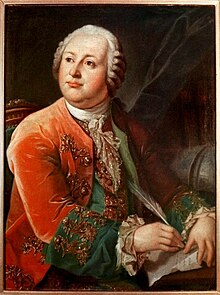Mikhail Vasilyevich Lomonosov
| Mikhail Lomonosov | |
|---|---|

Portrait by G. Prenner, 1787
|
|
| Native name | Михайло Васильевич Ломоносов |
| Born |
Mikhaylo Vasilyevich Lomonosov 19 November 1711 Denisovka, Archangelgorod Governorate, Tsardom of Russia |
| Died | 15 April 1765 (aged 53) Saint Petersburg, Russia |
| Nationality | Russian |
| Alma mater |
Slavic Greek Latin Academy St. Petersburg Academy University of Marburg |
| Spouse(s) | Elizabeth Christine Zilch |
| Scientific career | |
| Fields | Natural science, chemistry, physics, mineralogy, history, philology, poetry, optics |
| Institutions | St. Petersburg Academy |
| Academic advisors | Christian Wolff |
Mikhail Vasilyevich Lomonosov (/ˌlɒməˈnɔːsɔːf, -sɒf/;Russian: Михаи́л (Михáйло) Васи́льевич Ломоно́сов, IPA: [mʲɪxɐˈil vɐˈsʲilʲjɪvʲɪtɕ ləmɐˈnosəf] (![]() listen); November 19 [O.S. November 8] 1711 – April 15 [O.S. April 4] 1765) was a Russian polymath, scientist and writer, who made important contributions to literature, education, and science. Among his discoveries were the atmosphere of Venus and the law of conservation of mass in chemical reactions. His spheres of science were natural science, chemistry, physics, mineralogy, history, art, philology, optical devices and others. Lomonosov was also a poet and influenced the formation of the modern Russian literary language.
listen); November 19 [O.S. November 8] 1711 – April 15 [O.S. April 4] 1765) was a Russian polymath, scientist and writer, who made important contributions to literature, education, and science. Among his discoveries were the atmosphere of Venus and the law of conservation of mass in chemical reactions. His spheres of science were natural science, chemistry, physics, mineralogy, history, art, philology, optical devices and others. Lomonosov was also a poet and influenced the formation of the modern Russian literary language.
...
Wikipedia
